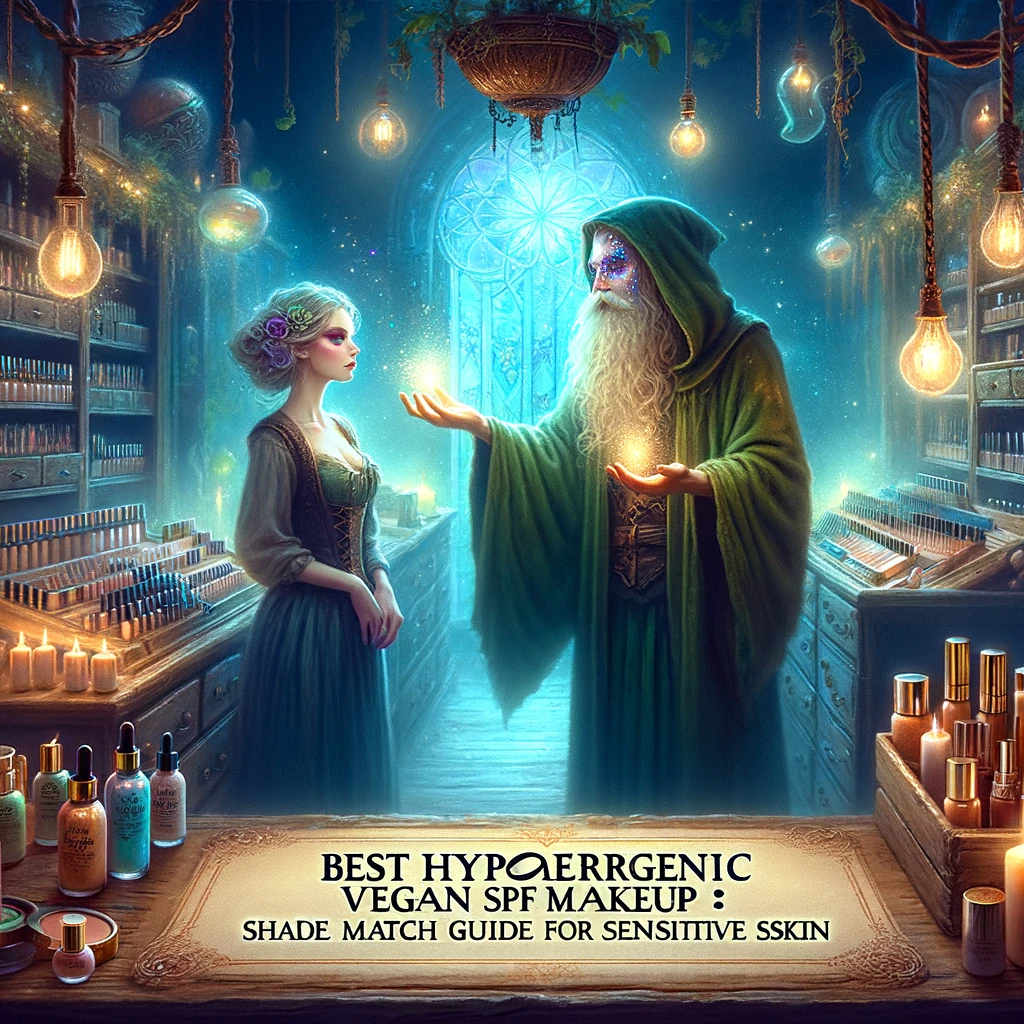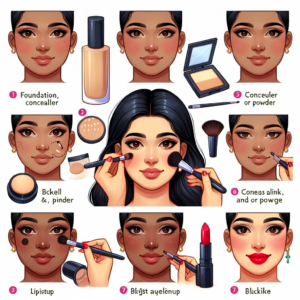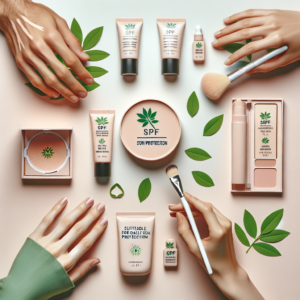
Key Takeaways
- Hypoallergenic vegan SPF makeup is perfect for sensitive skin, providing sun protection without irritation.
- Understanding your skin’s undertones is crucial for finding the right shade match.
- Look for products with a blend of coverage, finish, and a wide shade range to suit your specific skin needs.
- Proper application techniques can enhance the effectiveness of hypoallergenic makeup.
- Being informed about the ingredients and product labels helps you make the best choice for your skin.
| Product Name | SPF Rating | Suitable for Skin Types | Shade Range | Finish | Price Range |
|---|---|---|---|---|---|
| GreenGlow SkinShield SPF30 | SPF 30 | All skin types | 15 shades | Matte | $$ |
| PureRadiance SunGuard SPF50 | SPF 50 | Sensitive, Dry | 10 shades | Dewy | $$$ |
| EcoBelle SoftTouch SPF25 | SPF 25 | Oily, Combination | 8 shades | Semi-Matte | $ |
| NatureShade UVBlock SPF40 | SPF 40 | Dry, Normal | 12 shades | Natural | $$ |
| VitaBright ClearCover SPF35 | SPF 35 | All skin types | 20 shades | Radiant | $$$ |
Finding Your Perfect Shade
When it comes to makeup, one size does not fit all, especially if you have sensitive skin. But fear not, because finding your perfect shade of hypoallergenic vegan SPF makeup is a journey we’re about to embark on together. The goal? To arm you with the confidence to make beauty choices that are as safe as they are stunning.
Understanding Undertones in Sensitive Skin
First things first, let’s talk undertones. Your skin’s undertone is the color underneath the surface. You might have a cool, warm, or neutral undertone. Cool undertones have hints of blue or pink, warm undertones feature peachy, golden, or yellow hues, and neutral is a mix of both.
- Check your veins: Look at the veins on your wrist. If they appear blue or purple, you’re likely cool-toned. If they look green, you’re warm-toned. Can’t tell? You might be neutral.
- Consider your jewelry preferences: Silver typically complements cool undertones, while gold shines on warm undertones. If both look great, you might be neutral.
- Think about the colors you wear: Certain colors make you look radiant, right? Cool undertones sparkle in blues and purples, while warm undertones glow in earth tones like reds, oranges, and yellows.
Now that you know your undertone, picking the right shade of makeup will be much easier. And when it comes to sensitive skin, this knowledge is power. It means you can select hypoallergenic makeup that not only matches your skin tone but also won’t cause irritation.
Spotlight on Shade Matching Techniques
Shade matching can be tricky, but I’ve got some foolproof tips to make it a breeze. First, always test makeup in natural light. Store lighting can be deceiving, so step outside with a mirror if possible. Next, don’t limit your testing to your wrist or hand—the skin there often differs in tone from your face. Instead, apply a small amount along your jawline. The right shade will disappear into your skin without the need to blend excessively.
Remember, your neck and face should look like they belong to the same person, so matching your makeup to your neck’s skin tone is a safe bet for a seamless look. And if you’re stuck between two shades, always go for the lighter one. You can easily warm it up with a touch of bronzer or blush.
Why Your Sensitive Skin Will Love Hypoallergenic Vegan SPF Makeup
Choosing makeup for sensitive skin can feel like navigating a minefield. You want to look good, but not at the expense of your skin’s comfort. That’s where hypoallergenic vegan SPF makeup comes in. Not only does it minimize the risk of allergic reactions, but it also protects your skin from harmful UV rays.
The Irresistible Combo: SPF and Hypoallergenic
Sun protection is non-negotiable, even on cloudy days. UV rays can sneak through and cause damage, which is why SPF in your makeup is a game-changer. And when it’s hypoallergenic, you’re getting that essential protection without common irritants like fragrances or parabens that can upset sensitive skin.
Most importantly, when you opt for hypoallergenic vegan SPF makeup, you’re also saying no to animal byproducts and yes to plant-based goodness. This means you’re less likely to encounter harsh chemicals that can lead to redness, breakouts, or rashes.
Hypoallergenic and Vegan: A Match Made in Beauty Heaven
Why settle for less when you can have the best of both worlds? Hypoallergenic and vegan makeup products are kind to animals and your skin. They’re often enriched with natural ingredients that nourish and care for your skin while providing the coverage you desire.
These products are not only better for the environment but also for your skin’s overall health. By choosing them, you’re making a statement about the kind of world you want to live in—one that’s ethical, conscious, and beautiful.
The High-End Holy Grail for Your Skin
For those who don’t mind splurging a bit for top-notch quality, there are high-end hypoallergenic vegan SPF makeup options that are worth every penny. These products often boast advanced formulas, extensive research, and luxurious ingredients that pamper your skin. They’re the perfect blend of science and indulgence, providing peace of mind and a flawless finish.
Application Tips for an Impeccable Finish
Now that you’ve found your perfect hypoallergenic vegan SPF makeup, let’s talk about application. How you apply your makeup is just as important as the makeup itself, especially for sensitive skin. The right technique can mean the difference between a cakey mess and a smooth, natural look.
Preparing Your Skin for Makeup
Before you even think about foundation or concealer, start with a clean canvas. Gently cleanse your face to remove any impurities or excess oil. Follow up with a hydrating, hypoallergenic moisturizer to ensure your skin is supple and ready for makeup. This step is crucial because hydrated skin means makeup will glide on smoothly and stay put.
Application Secrets for a Smooth, Even Coverage
When it’s time to apply your makeup, use a damp beauty sponge or a foundation brush for an airbrushed finish. Start from the center of your face and blend outwards. Less is more—build coverage gradually to avoid a heavy look. And don’t forget to blend down your neck for a seamless transition!
For areas that need a bit more attention, like under-eye circles or blemishes, a hypoallergenic concealer is your best friend. Dab it on with a light hand and blend carefully. Set everything with a fine, hypoallergenic setting powder to lock your look in place and minimize shine.
- Use a damp beauty sponge for a dewy finish.
- Opt for a foundation brush if you prefer a full coverage look.
- Always blend outwards from the center of your face.
- Build coverage slowly to avoid caking.
- Set your makeup with a hypoallergenic setting powder to prolong wear.
Maximizing the Effectiveness of Your SPF Makeup
SPF in your makeup is a fantastic way to protect your skin, but there are ways to maximize its effectiveness. Remember, SPF makeup is not a substitute for sunscreen. For the best protection, start with a layer of hypoallergenic sunscreen before your makeup. This provides a solid base of sun defense, and your SPF makeup will boost that protection.
Another tip is to reapply throughout the day. Sun protection isn’t a one-and-done deal; it wears off over time. Use a setting spray with SPF or a mineral SPF powder to touch up without disturbing your makeup.
How to Enhance SPF Protection in Your Makeup Routine
To enhance SPF protection, consider these additional steps:
- Apply a base layer of broad-spectrum sunscreen before your makeup.
- Choose makeup products with an SPF of at least 30 for adequate protection.
- Reapply SPF every two hours if you’re spending the day outdoors.
- Use SPF-infused lip products to protect your lips, which are often overlooked.
Maintenance Tips: Keeping Sensitive Skin Happy
Maintaining the health of your sensitive skin doesn’t stop at makeup application. Throughout the day, avoid touching your face to prevent transferring dirt and oils. In the evening, remove your makeup with a gentle, hypoallergenic makeup remover. Follow up with your skincare routine to nourish your skin while you sleep.
And don’t forget to regularly clean your makeup tools! Brushes and sponges can harbor bacteria, which can lead to breakouts or irritation. Wash them weekly with a gentle cleanser to keep your skin—and your makeup application—pristine.

Making Informed Choices for Sensitive Skin
Knowledge is power, especially when it comes to selecting makeup for sensitive skin. Understanding what’s in your makeup and how it affects your skin is the first step towards making choices that you can feel good about.
The Importance of Reading Labels and Ingredients
Always read the labels on your makeup products. Look for key terms like ‘hypoallergenic’, ‘non-comedogenic’, ‘fragrance-free’, and ‘vegan’. These indicate that a product is less likely to cause a reaction. But don’t stop there—scan the ingredients list for anything you know irritates your skin or that you’re allergic to.
Remember, just because a product is labeled ‘natural’ doesn’t mean it’s gentle. Some natural ingredients can be harsh on sensitive skin. So, do your homework, and when in doubt, patch test a new product before applying it to your face.
Evaluating Products Beyond the Label – What to Look For
Beyond the label, consider the brand’s reputation and reviews from other users with sensitive skin. A brand that consistently produces hypoallergenic and vegan products is more likely to understand your skin’s needs. And real-world feedback can provide insights into how a product performs in daily life.
Don’t be afraid to reach out to brands with questions about their products. A trustworthy brand will be transparent and happy to help you understand whether their makeup is right for you.
Armed with this knowledge, you’re well on your way to making beauty choices that not only make you look great but also keep your sensitive skin happy and healthy. Remember, beauty is about feeling confident and comfortable in your own skin—so choose products that align with your values and your skin’s needs.
Making Informed Choices for Sensitive Skin
As someone who treasures their sensitive skin, making informed choices about your makeup is crucial. It’s about more than just the look—it’s about health and well-being. To ensure you’re selecting the best hypoallergenic vegan SPF makeup, there’s a little homework to be done. But don’t worry, I’m here to guide you through it.
The Importance of Reading Labels and Ingredients
Labels can be your best friend or your worst enemy. They hold the secrets to what’s inside your makeup, and it’s vital to understand them. Look for products labeled as ‘hypoallergenic’, ‘non-comedogenic’, ‘fragrance-free’, and ‘vegan’. These terms are your first indication that the product is designed to be gentle on your skin. But, go one step further—read the ingredients list. If you see anything you don’t recognize or can’t pronounce, it might be worth a quick search to ensure it’s safe for your sensitive skin.
Evaluating Products Beyond the Label – What to Look For
When it comes to evaluating products, the label is just the start. Take a deep dive into the brand’s ethos, ingredient sourcing, and manufacturing processes. A brand that values transparency and caters to sensitive skin will often provide comprehensive information about their products. Additionally, customer reviews can offer invaluable insights. Pay attention to feedback from individuals with similar skin concerns, as their experiences can be a good indicator of how your skin might react.
Also, consider reaching out to the brand directly. A reputable brand will be more than willing to discuss your concerns and help you understand if their product is a good match for your sensitive skin. Their response—or lack thereof—can tell you a lot about their commitment to customers like you.
FAQ
What does “hypoallergenic” actually mean?
‘Hypoallergenic’ means that a product is less likely to cause an allergic reaction. However, it’s not a guarantee. There are no strict regulations governing the use of this term, so it’s still important to check the ingredients list for known irritants or allergens.
How do I reapply SPF makeup throughout the day?
To maintain effective sun protection, reapplying SPF is a must, especially if you’re outdoors. Opt for a mineral SPF powder or a setting spray with SPF to touch up your makeup without smudging it. These products are easy to apply and can be carried in your purse for on-the-go protection.
Can vegan makeup provide adequate sun protection?
Absolutely! Vegan makeup can offer the same level of sun protection as non-vegan options. Just look for products with an SPF rating of at least 30 to ensure you’re getting adequate coverage.
How can I tell if a shade matches my skin tone?
Finding your match is all about testing. Swipe a bit of foundation along your jawline—if it blends seamlessly without much effort, you’ve found your shade. Remember to test in natural lighting for the most accurate result.
What are the benefits of using hypoallergenic makeup for sensitive skin?
Hypoallergenic makeup is designed with sensitive skin in mind. It typically avoids common irritants and allergens, reducing the risk of skin reactions. Using hypoallergenic products can help keep your skin calm, clear, and comfortable.
In conclusion, choosing the right hypoallergenic vegan SPF makeup involves understanding your skin’s needs, knowing what ingredients work for you, and being informed about the products you’re considering. By following these guidelines, you can enjoy beautiful makeup that protects and respects your sensitive skin. Remember, the most beautiful thing you can wear is confidence, and that starts with making choices that are good for you and your skin.




